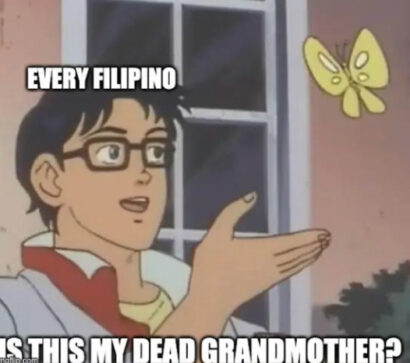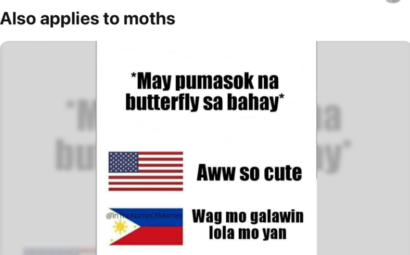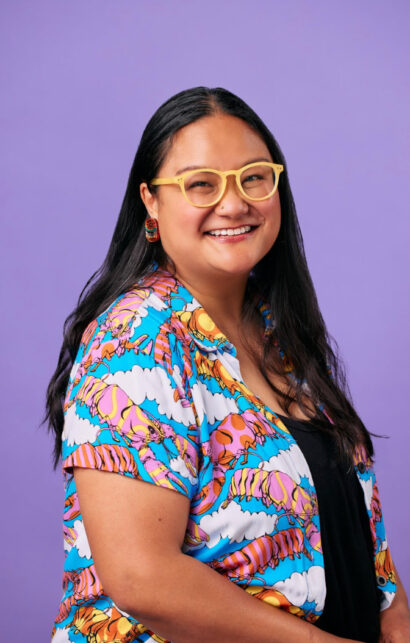What We Can Do With Our Hands: On Collage
You can read/view Michelle Peñaloza's poems and collages in BR's Issue 86 here. I.
I started making collages at the start of this year, the day after I learned the pregnancy, we’d been trying to make happen for two years, was not viable. The day I waited for a way to help my body—what is the verb? Clear? Deal? Contend?—with my miscarriage. (As I write this, I’m at an artist residency I’ve known about since last year; every day I wake up here, I think about how I would’ve been 21 weeks pregnant when I arrived and 25 weeks pregnant when return home, had I not had a miscarriage.)
We live in a rural area with two gas stations, one grocery store, no traffic lights, a couple of food trucks, a NAPA AutoParts, a True Value and no pharmacy. Alex, my partner in life, in this grief, in losing our little one, had to drive an hour one way to get the misoprostol—the pill, the option I chose instead of a DNC or waiting for my body to do the work—for clearing my miscarriage from my body. As I reread that sentence, it reads so flat, so sparse in comparison to the visceral devastation of my experience. I know I am supposed to be writing a process note about collage here; but, herein is part of my process: alone for several hours with our little one, who we’d hoped to welcome into the world, who was a little, little unalive being still inside and a part of me, I wasn’t sure what to do with myself.
In moments when writing is inaccessible as a means for me to process or reach myself, I need things to do with my hands. I’ll work in the dirt in our garden, I’ll cook something. That day was cold, January. I wasn’t hungry.
What I felt I needed to do alone that afternoon: cut out bunny after bunny with an X-acto knife.
2023 is the Year of the Rabbit (or the Cat, depending) and I had been thinking of our little one, their spirit as a little bunny. I’d been reading how those born in the Year of the Rabbit are gentle, kind, clever, calm. When I discovered I was pregnant in December, I’d thought it was fortuitous that my office calendar for 2022 was month after month of bunnies. The only other materials in our house that I could cut up were old food magazines and vegetable and flower seed catalogs.
So, I began gluing my bunnies, placing these little ones in fantastic landscapes of orange slice mountains, tomato planets, sushi sunsets. I surrounded them with stock and celosia.
These collages were a way for me to reach my little one, to offer them joy, playfulness, beauty, lushness, juiciness, flavor, color—all the things I so wished to share with them as they grew inside me, as we grew together.
It helped. I cried and I cut out precise images of bunnies, sunflowers, lettuce, cans of shiny sardines.
Before I became pregnant, I had this vision of a little child, head of black hair bobbing around, following my every move in our kitchen, asking what’s this, what’s that, wanting to help, wanting to see and touch and smell and taste everything.
I think I began making these first bunny collages to reach her. To create a space for him. To make a way to hold and carry my little one who I will not meet in this life.
Something opened for me then in making these first collages, in this act of creation and care for myself and for my little one. The act of reaching out, of creating allowed me to access what I have been also able to access in writing poems, especially poems where I address my beloved dead.
Collage, like poetry, is a series of choices; is a gathering process. Both poetry and collage can feel transformative, alchemical. In collage, using scale and juxtaposition, one can create opportunity for lyricism, for latent narrative, for associations and new meanings made, for capturing multiple truths, for reimagining, for collapsing time and space and the various veils between us.
II.
I have a cheap, flip-able frame I got when I was teenager, purchased from TJ Maxx, not long after my father died where I keep many favorite pictures of him:
–my father, a sunny brown and smiling, sitting with a giant lobster
–my father on a street in Baguio, in front of a 3-story McDonald’s, two women walking behind him with baskets of mangos on their heads
–my father looking through a telescope, wearing swim trunks
–my father in a stream, holding his hand out to a waterfall on family land in Laguna
–my father seated a mahjong table, leaning back in his chair, in the middle of saying something, probably loudly
–my father in the backseat of our Blazer, stretched out smiling and eager to nap during the last road trip we’d ever take, the first one where I could drive with my newly acquired driver’s license
I started photocopying these images and reaching out to my father. I cut him out of the backseat of our Blazer and I surrounded him with butterflies and flowers.
Y’know these memes?


Winged things, especially butterflies and moths, are our beloved dead, come back to visit us. I suppose this collage I describe, which I’ve titled, Hanggang Sa Muli, is my visitation to my father, a space for our visitation with each other.
When folks texted to check on me, to see how I was/am coping with my grief after my miscarriage, I shared these collages: “I think I am on to something; I feel like this work makes sense with what I’ve been trying to do with the stereographs and archives from the Philippine American War.”
III.
I’ve been looking at these images, there are hundreds of them, mostly found in three places—digital collections at the University of Michigan and in the Library of Congress and being sold on eBay (people love collecting artifacts of colonization)—on and off, for fourteen years. Many are captioned, descriptions typed below the images as a part of the stereograph itself, or handwritten, in the case of personal albums of US military personal (oftentimes, the very same soldiers who “pacified” Native peoples in the American West):
–Dead Filipino on the battlefield near Malabon, Philippine Islands
–After a Typhoon Wherever the Roof Lands There the Filipino Makes His Home
–“It was Evident that he was a Personage of No Little Importance”
–Insurgent prisoners guarded by American soldiers bearing insurgent dead. North of Malinta, Bulancan Province – 1899
–School Girl in Native Dress, Upper Garment Made of Hemp Gauze
–Filipino women seeking help from American soldiers
My earliest work trying to engage with these images was clumsy and, worse yet, I also felt as though I could not help but reify the violence already twice done to the people “captured” in these images. I’d leave these images, needing to give myself space from their violence and atrocity, trying to figure out a way to figure out, as Saidiya Hartman writes, “How does one revisit the scene of subjections without replicating the grammar of violence?” Still, I found myself called again and again to engage, because of the amnesia that pervades the history of US Imperialism; because my mother and I would argue when she’d say that the US had to step in and establish colonial rule because, “We were not ready;” because I didn’t learn about the Philippine American War until I was in college; because these very images were used as justification for the US colonizing the Philippines; because the primitive 3D of stereographs brought the abject other of Filipinos into view for American consumption; because the US State Department to this day says, “as many as 200,000 Filipino civilians died” during the Philippine American War, where most historians quote upwards of 775,000 to 1 million Filipinos; because of the violent and ironic tensions between the captions and the images themselves, wherein dead bodies in a rice paddy cannot be threats, wherein soldiers do not look to be helping nor do Filipino women look as though they are seeking any help, wherein the actual images of Filipino people subverts the condescension and erasure of them into objects, written in a colonizer’s captions.
So, then, collages. I am still at the start of this work but have found creating collages with images from the archive has become a way in, a way to hold and carry grief of a history made invisible, a means to reach out and create space for visitation, for homage within the work of destabilizing of these “historical documents” and narratives of empire.
Saidiya Hartman offers Octavia Butler’s Kindred as a model for practice: “When Dana, the protagonist of Butler’s speculative fiction, travels from the twentieth century to the 1820s to encounter her enslaved foremother, Dana finds to her surprise that she is not able to rescue her kin or escape the entangled relations of violence and domination, but instead comes to accept that they have made her own existence possible.”
In a collage, I can briefly protect and enclose and, maybe, create a kind of rest, by carefully covering a perpetually violated, unnamed “Dead Filipino” in delicate flowers that I’ve cut from seed catalogs. In a collage, I can collaborate in subversion with the “School Girl in Native Dress,” highlighting the discrepancy between the gaze with which the colonists’ camera captures her and the gaze which she gives to the camera by removing her image from one half of a stereograph and replacing it with the spikes of regal cacti.
It is the impotence of actual revision—I am no longer pregnant and don’t know that I ever will be again; my father is still dead; the people in these archival images will never be un-murdered by the greed of empire, will never be laid to proper rest—that makes this work so potent with possibility: the point is the reaching, the forever unanswered missive, the what we can do with our hands.
Michelle Peñaloza is the author of Former Possessions of the Spanish Empire, winner of the 2018 Hillary Gravendyk National Poetry Prize (Inlandia Books, 2019). She is also the author of landscape/heartbreak (Two Sylvias, 2015) and the recipient of fellowships and awards from the University of Oregon and Kundiman. Michelle has also received support from the Barbara Deming Memorial Fund, Loghaven, Willapa Bay AIR, Caldera, 4Culture, Artist Trust, PAWA (Philippine American Writers and Artists), Literary Arts, VONA/Voices, and the Bread Loaf Writers' Conference, among others. The proud daughter of Filipino immigrants, Michelle was born in the suburbs of Detroit, MI and raised in Nashville, TN. She lives in rural Northern California.
